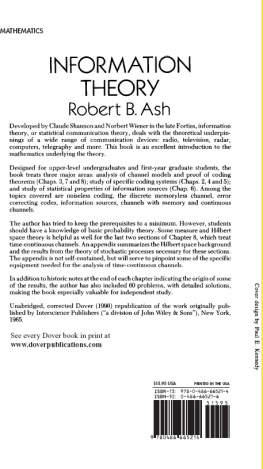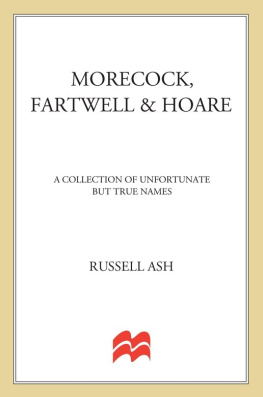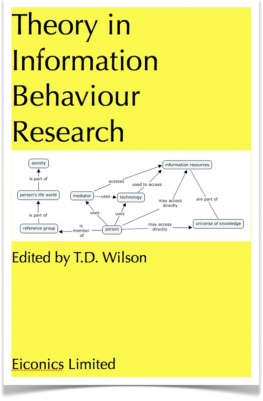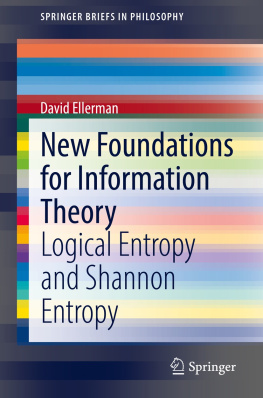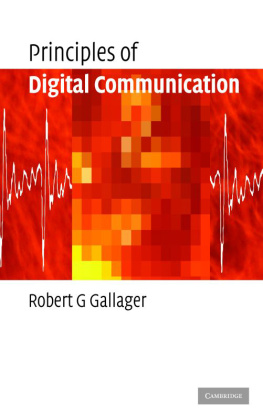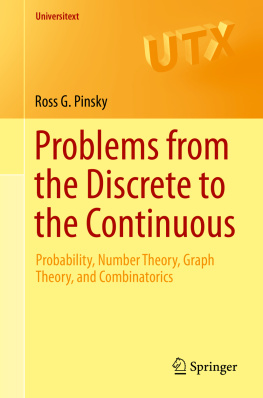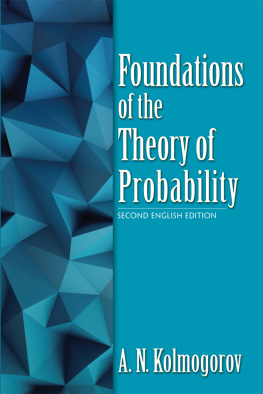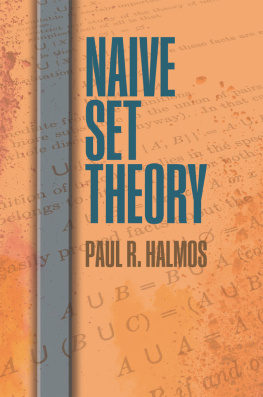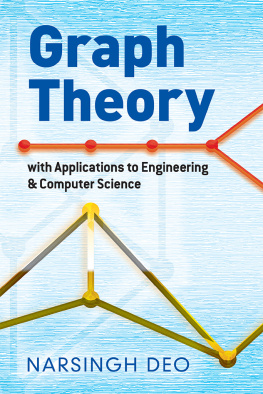Copyright 1965 by Robert B. Ash.
All rights reserved.
This Dover edition, first published in 1990, is an unabridged and corrected republication of the work originally published by Interscience Publishers (a division of John Wiley & Sons), New York, 1965.
Ash, Robert B.
Information theory / by Robert B. Ash.
p. cm.
Includes bibliographical references and index.
Information theory. I. Title.
PREFACE
Statistical communication theory is generally regarded as having been founded by Shannon (1948) and Wiener (1949), who conceived of the communication situation as one in which a signal chosen from a specified class is to be transmitted through a channel, but the output of the channel is not determined by the input. Instead, the channel is described statistically by giving a probability distribution over the set of all possible outputs for each permissible input. At the output of the channel, a received signal is observed, and then a decision is made, the objective of the decision being to identify as closely as possible some property of the input signal.
The Shannon formulation differs from the Wiener approach in the nature of the transmitted signal and in the type of decision made at the receiver. In the Shannon model, a randomly generated message produced by a source of information is encoded, that is, each possible message that the source can produce is associated with a signal belonging to a specified set. It is the encoded message which is actually transmitted. When the output is received, a decoding operation is performed, that is, a decision is made as to the identity of the particular signal transmitted. The objectives are to increase the size of the vocabulary, that is, to make the class of inputs as large as possible, and at the same time to make the probability of correctly identifying the input signal as large as possible. How well one can do these things depends essentially on the properties of the channel, and a fundamental concern is the analysis of different channel models. Another basic problem is the selection of a particular input vocabulary that can be used with a low probability of error.
In the Wiener model, on the other hand, a random signal is to be communicated directly through the channel; the encoding step is absent. Furthermore, the channel model is essentially fixed. The channel is generally taken to be a device that adds to the input signal a randomly generated noise. The decoder in this case operates on the received signal to produce an estimate of some property of the input. For example, in the prediction problem the decoder estimates the value of the input at some future time. In general, the basic objective is to design a decoder, subject to a constraint of physical realizability, which makes the best estimate, where the closeness of the estimate is measured by an appropriate criterion. The problem of realizing and implementing an optimum decoder is central to the Wiener theory.
I do not want to give the impression that every problem in communication theory may be unalterably classified as belonging to the domain of either Shannon or Wiener, but not both. For example, the radar reception problem contains some features of both approaches. Here one tries to determine whether a signal was actually transmitted, and if so to identify which signal of a specified class was sent, and possibly to estimate some of the signal parameters. However, I think it is fair to say that this book is concerned entirely with the Shannon formulation, that is, the body of mathematical knowledge which has its origins in Shannons fundamental paper of 1948. This is what information theory will mean for us here.
The book treats three major areas: first ( ). All three areas were introduced in Shannons original paper, and in each case Shannon established an area of research where none had existed before.
The book has developed from lectures and seminars given during the last five years at Columbia University; the University of California, Berkeley; and the University of Illinois, Urbana. I have attempted to write in a style suitable for first-year graduate students in mathematics and the physical sciences, and I have tried to keep the prerequisites modest. A course in basic probability theory is essential, but measure theory is not required for the first seven chapters. All random variables appearing in these chapters are discrete and take on only a finite number of possible values. For most of , which treat time-continuous channels. An appendix summarizes the Hilbert space background and the results from the theory of stochastic processes that are necessary for these sections. The appendix is not self-contained, but I hope it will serve to pinpoint some of the specific equipment needed for the analysis of time-continuous channels.
.
is carried out by a matrix development rather than by the standard approach, which uses abstract algebra. The matrix method seems to be natural and intuitive, and will probably be more palatable to students, since a student is more likely to be familiar with matrix manipulations than he is with extension fields.
I hope that the inclusion of some sixty problems, with fairly detailed solutions, will make the book more profitable for independent study.
The historical notes at the end of each chapter are not meant to be exhaustive, but I have tried to indicate the origins of some of the results.
I have had the benefit of many discussions with Professor Aram Thomasian on information theory and related areas in mathematics. Dr. Aaron Wyner read the entire manuscript and supplied helpful comments and criticism. I also received encouragement and advice from Dr. David Slepian and Professors R. T. Chien, M. E. Van Valkenburg, and L. A. Zadeh.
Finally, my thanks are due to Professor Warren Hirsch, whose lectures in 1959 introduced me to the subject, to Professor Lipman Bers for his invitation to publish in this series, and to the staff of Interscience Publishers, a division of John Wiley and Sons, Inc., for their courtesy and cooperation.
Urbana, Illinois
July, 1965 | Robert B. Ash |

